|
|
|
|
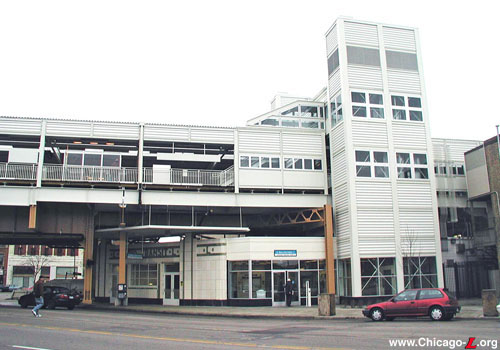 The renovated Western station, with its restored Art Deco front facade maintained amongst the otherwise newly-constructed facility, is seen looking northeast on November 30, 2001. For a larger view, click here. (Photo by Graham Garfield) |
|
|
|
|
 The renovated Western station, with its restored Art Deco front facade maintained amongst the otherwise newly-constructed facility, is seen looking northeast on November 30, 2001. For a larger view, click here. (Photo by Graham Garfield) |
Western
(2400W/1900N)
Western Avenue, Cortland
Street and Milwaukee Avenue, Logan Square
Service Notes:
Blue Line: O'Hare
Accessible Station
Owl Service
Quick Facts:
Address: 1909-11 N. Western Avenue
Established: May 25, 1895
Original Line: Metropolitan West Side Elevated, Logan Square branch
Previous Names: none
Rebuilt: 2000-01
Skip-Stop Type:
Station
Status: In Use
History:
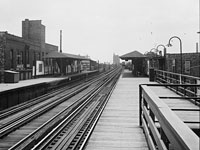
Western station's platforms are seen looking southeast on June 4, 1962. The station's original 1895 hipped-roof latticed-support canopies are still in place. The simple angle-iron railings in the foreground are on later extensions of the original platforms. For a larger view, click here. (CTA photo, Graham Garfield Collection) |
Western was built as part of the Metropolitan West Side Elevated's Northwest Branch (aka Logan Square Branch) in 1895. The station house is typical of Met designs on the Northwest and Garfield Park branches. Built by the Jonathan Clark & Sons Company for the general contractor, Alfred Walcott, the stations were designed by the engineering staff of the Metropolitan company. Constructed of red pressed brick with stone sills and foundations, their vernacular style might best be described as Queen Anne-influenced with some Romanesque features. The station's original design was highlighted by the semicircular bay/portico, a lattice pattern in the brick cornice, extensive terra cotta work including the word "entrance" above one door in the portico and "exit" above the other (although there is nothing to force ingress from one and egress from the other), dentals above the doors' story lights, and carved wooden beads flush with the building between the wooden brackets which support a wooden canopy over the portico. The small station house's interior had plaster walls with wooden door and window frames, moldings, and wainscotting, and wooden floors.
The stations had dual side platforms, with canopies and railings typical of all Met stations: Designed into the railings were larger cast iron square plates with a stylized diamond design. The stairs and platforms were constructed of wood on a steel structure. Each platform had a short canopy in the center of the platform, covering the stairs and a small waiting area. The canopy frame was iron, with arched latticed supports and bracketed rafters, and hipped roofs of corrugated tin.
As occurred with most "L" stations, modifications were later made to the Western station facility. Perhaps the most important was to the front facade (west elevation). In the 1930s, Western Avenue, the longest street in Chicago and an important north-south thoroughfare, was widened for its entire length. The Metropolitan Elevated had four stations along Western on various branches and used an usual solution to the encroachment on their property. Instead of demolishing the station houses wholesale and erecting a new buildings further back on their property, the Met retained their station buildings, cropped off their fronts, removed several feet from the footprint of the structure, and added a new front facade at the new property line. Rather than try to design a new front to mesh with the style of the original building, the new fronts used a radically different, decidedly modern style.
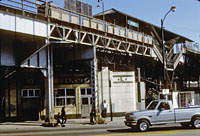
The original Metropolitan Elevated canopy and railings, with their large cast iron square plates with stylized diamond design interspersed with twisted metal straps, are seen overhead in this view looking east in 1996. The 1930s Art Deco facade is visible underneath the elevated structure. The station is intact historically in many regards but is looking shop-worn by this point. For a larger view, click here. (Photo by John Smatlak) |
Although the addition of the modern facade was perhaps the most severe change to the station, several other modifications were performed as time went on. The interior was changed since the station house was built, with the most severe rearrangement occurring when the Deco front was added and the building was cut back. Into the Fall of 2000, the platforms retained their original canopies and railings and the northbound platform still had a few of its original, unique 1895 shepherd's crook lights, seen only on the early Met "L" stations.
A New Station with an Old Facade
CTA planned to extensive renovated the Western station was far back as the mid-1980s. By 1985, design work was underway; at that time, construction was projected to be completed in 1988. By the early 1990s no work had been undertaken, but designs and artist's renderings had been prepared.
On September 15, 1999, the CTA announced that the Western station would be dismantled, restored and rebuilt in the following 16 months. The work at Western/Milwaukee included a new station house, platforms, canopy, stairs, customer assistant kiosk, electrical, communication, and HVAC systems, and two elevators to make station ADA-accessible. The historic terra cotta facade and north brick wall would be integrated into the new station house.
Station Design
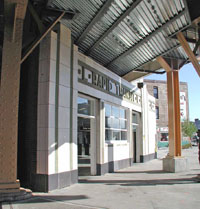
Cleaned and restored, the 1930s-vintage terra cotta Art Deco facade of Western station once again greets passengers as part of the renovated station, seen looking southeast on September 27, 2001. The metal "drip pan" canopy overhead will not only protect pedestrians on the sidewalk but the station facade as well from debris as well as oil, grease and creosote from the tracks above. For a larger view, click here. (Photo by Graham Garfield) |
The Western station renovation project included the construction of a new station house on the east side of Western Avenue. By the mid-1980s, the Illinois Historic Preservation Agency had determined the Western station to the eligible for the National Register of Historic Places, and the Commission on Chicago Historical and Architectural Landmarks stated that the Art Deco facade should be preserved if possible. Therefore, the new station house's design included preserving and restoring both the 1930s front facade as well as the original Queen Anne north facade along the alley, integrating them into a new facility to be build behind them. The rest of the existing station house elevations and interior were demolished and replaced. The new south exterior elevation, which faced a plaza next to the station, was built with new, modern materials -- tall glass windows and white facing -- but in a design and scale that complimented the Art Deco elevation. The Art Deco facade received new doors and windows, and the terra cotta surfaces were cleaned and restored.
The new interior features poured concrete floors and white glazed tile walls with full-height windows on the south elevation. The ceiling featured inset, flush-mounted lighting and white metal paneling. A concession space is provided on the north side of the unpaid portion of the interior. A new stainless steel Customer Assistant booth was provided, octagonal in shape in a design near-identical to those installed around the same time at Garfield, UIC-Halsted, and other locations.
New, wide stairs lead from the rear of the station house to an intermediate landing, splitting and landing to each new side platform. Elevator access is provided as well; however, there are not elevators directly to each platform. Because of the tight confines of the station site and the presence of an alley immediately to the north of the station house and under the northbound platform, it was not possible to have the elevator on the northbound platform descend to street level. Therefore, the single elevator in the rear of the station house leads to both the southbound platform and a transfer bridge over the tracks. From the transfer bridge, another elevator leads to the northbound platform. The transfer bridge is also accessible from stairs from each platform.
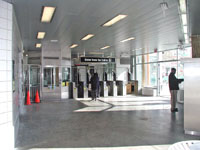
The bright, open interior of the new Western station, seen looking southeast on September 27, 2001, is typical of stations built around around the turn of the 21st century, with its concrete floor, white tile walls, large windows, octagonal steel CA booth, and white metal panel ceiling. For a larger view, click here. (Photo by Graham Garfield) |
The project included replacing both platforms as well as support beams that span Western Avenue. The current 1895 platforms and canopies were replaced with new wider platforms. The shorter original 1895 canopies were replaced with a large new canopy running the full length and width of the rebuilt platforms. The canopy is supported by columns along the rear edge of the platform, with a corrugated roof supported by crossbeams with a hexagonal shape cut out in a repeating pattern. The canopy roof runs the length of the platform and covers the full width of each as well as part of the tracks, but has an opening down the centerline of the tracks to provide some natural light. The design of the canopy is nearly identical to the one at Polk, built nearly 20 years early but designed within a few years of one another. Dual raceways hiding conduit run length-wise over each platform on which lighting is mounted. The platform floor was wood decking. Railings are metal, in a simple square tubular design.
The rebuilt station includes two new auxiliary entrance stairways on the west side of Western Avenue. One stair leads directly to each of the side platforms. High-Barrier Gate (HBG) turnstiles at platform level control access in and out of the auxiliary entrances and require the passenger to have a valid farecard to enter. The stairs provide convenient access to the neighborhood and facilitate transfers between the Blue Line and buses on Western Avenue, both preventing the need to cross the wide, busy thoroughfare.
Other amenities included audio/visual LED signs, new signage including Braille, and tactile edging at the platform level and at the top of the stairs.
Station Construction
The Art Deco facade of Western station stands solemnly on January 5, 2001, striped of the sides and rear of the original structure. It stands supported by wooden beams and braces awaiting integration into the new station facility. For a larger view, click here. (Photo by Graham Garfield) |
As a precursor to heavy work beginning on the existing station facility, the new auxiliary entrance stairs on the west side of Western Avenue were built first. The stairways were put into service as temporary entrances at 10am, Tuesday, June 27, 2000. At that time, the station house on the east side of the street was closed for rehabilitation until 2001.
By January 2001, the sides and rear of the station were demolished, with only a small corner at the rear remaining around New Year's. The Art Deco facade was kept in place, held upright by wooden beams and supports. Plywood boards encased parts of the cornice and capitals along the roofline, presumably to protect them while work progresses on the platforms above. Construction of new steelwork that was necessary to support the new platforms and canopies had begun and progressed over the following months. Nothing had been removed from the platforms as of January 2001, except the original stairs down to the old station house.
By late March, work on the new platforms and elevated structure was continuing. Additional bent supports were added to support the larger platforms. The new side platforms were being constructed, with the old platform canopies gone and the superstructure of the new full-width canopy just about completed. The gooseneck shepherd's crook light were removed, replaced with temporary lights strung on a cable. The remnants of the old station house had not been significantly altered in the previous several months. The old Art Deco front facade still stood, supported by wooden braces. The 1895 north wall at what was the northeast (rear left) corner of the building was still standing, partially demolished.
Construction continues at platform level, looking southeast on July 13, 2001. The metal skeleton of the canopy and elevator towers are in place. For a larger view, click here. (Photo by Graham Garfield) |
By late September 2001, the station rebuilding project was nearly complete. The side platforms were almost finished, with the floor decking, canopy supports, canopy roofing, railings, lights, LED A/V signs, and windbreaks installed. During the third week of September, the platform symbol signs were installed as well. Work on the auxiliary entrances/exits on the west side of Western Avenue, installation of the station name signs and other signage, and other station finishes were still underway.
Major work was substantially complete in September 2001, with construction completed by November 2001.
Recent Developments
In September 2004, Dunkin' Donuts, the coffee and baked goods chain, opened five new concessions in CTA stations around the "L" system. One such new concession was located at Western/Milwaukee station. "This is the first major concerted effort to open a significant number of Dunkin' Donuts stores in CTA stations," said Mike Lavigne, director of development for Dunkin' Donuts. All new Dunkin' Donuts/CTA station stores were scheduled to be full-service.
Your New Blue: Station Improvements
On December 5, 2013, Mayor Rahm Emanuel and Governor Pat Quinn announced a comprehensive improvement plan for the Blue Line O'Hare Branch (including the northern portion of the Dearborn Subway), an overhaul that will provide faster travel times and updated stations while creating more than 1,300 jobs.
The $492 million plan, called Your New Blue, includes several track and station improvement projects along a 12.5-mile stretch of the Blue Line between the Grand and Cumberland stations, as well as upgrades to the signal system between the Jefferson Park and O'Hare stations. The overall Your New Blue program, beginning construction in 2014 and planned to last four years, is a package of several discrete projects ranging from station improvements to track renewal, signal replacement, traction power upgrades, and subway tunnel water mitigation efforts.
Western is one of the stations planned to receive improvements under the program. The scope of these improvements includes installation of public art at station house, upgrade of the existing station house entrance plaza with the replacement of existing picnic tables with new cafe tables and the installation of secure bike storage, upgrade of the existing station house entrance with the installation of new canopy over the sidewalk incorporating LED lighting to highlight the historic station facade, and replacement of existing metal roofing, handrails and guardrails on the north and south stairs.1
On February 5, 2014, the Chicago Transit Board approved the award of a $25.6 million design/build contract for the rehabilitation of the Damen, Western and California stations. F. H. Paschen, S.N. Nielsen and Associates, LLC was awarded the station rehabilitation contract following a competitive procurement process.2
At the same meeting, the Board also approved contracts for artists to develop unique artwork for each station that reflects the neighboring community and will beautify the stations for customers' enjoyment. After reviewing 100 responses to a Call for Artists issued in December 2013 for artistic merit and related qualifications, the CTA awarded the contract to create public art for Western station to Edra Soto and Dan Sullivan of Chicago.3
The auxiliary entrance for the O'Hare-bound platform was taken out of service at 9am, Monday, October 20, 2014 for rehabilitation of the stairway. The stairway reopened at 8am, Wednesday, October 29, 2014.
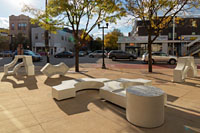
The art installation at the Western station, Remnants | Restos, is a series of "functional sculptures" in the plaza on the south side of the station house,seen soon after installation. For a larger view, click here. (Photo by Aron Gent, courtesy of the CTA) |
New, one-of-a-kind artwork served as the finishing touch for the Western Blue Line station, as part of the renovation and upgrades as part of the Your New Blue program.
CTA issued a Call for Artists in 2014 for the Western project, and artist for the Western installation were selected from a competitive field of other artists based on their artistic merit, qualifications, professional recognition, and their written statements of interest. The Western art installation was created by the Chicago-based artist team of Edra Soto and Dan Sullivan.
Known as Remnants | Restos, this art installation was intended to be a "functional sculpture" (furniture). The artwork was fabricated of cast concrete with blue terrazzo embellishments and are attached to the plaza with galvanized steel supports. The pieces are a permanent feature of the outdoor plaza at the Western station entrance. In collaboration with the artist-team, CTA also added in ground lighting in the plaza and relocated a bicycle rack for improved function of the outdoor space. The artists state that the sculptures present recognizable architectural forms and shapes that celebrate the culture and heritage of the adjacent communities which include Bucktown, Wicker Park and Humboldt Park.
Federal Formula Funds provided by the Federal Transit Administration (FTA) were used to pay for this art project and another at the Addison Blue Line station. The two installations were valued at $270,000, which covered costs associated with artists' fees, design, materials, fabrication, delivery, and contingency.
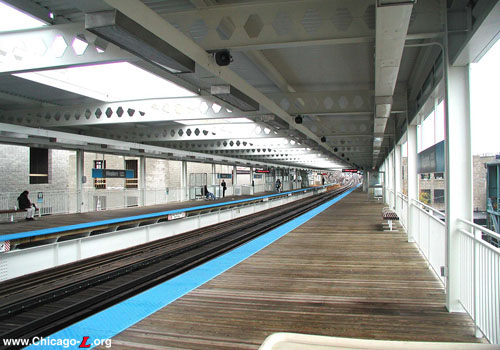
The rebuilt platforms at the Western O'Hare branch station are seen looking northwest on the O'Hare-bound platform on November 30, 2001. The renovated station included wider platforms and a full-length canopy that completely covered the platform area, save for the area over the centerline of the tracks. The canopy supports, beams and railings are simple and unadorned, save for the hexagonal cutouts in the crossbeams, all typical of station designs of the late 1970s-early 1990s. For a larger view, click here. (Photo by Graham Garfield) |
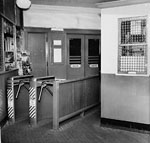 |
western-milwaukee01.jpg (270k) The interior of the old Western station house is seen looking east in the unpaid area on February 21, 1958. The already-modest size station house was made even smaller when Western Avenue was widened in the 1930s and the footprint of the station house cut back. Nonetheless, a concession space was still managed to be fit inside. (CTA photo, Graham Garfield Collection) |

|
cta2147.jpg (109k) |
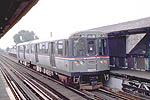
|
cta3193.jpg (120k) |
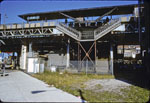 |
western-milwaukee04.jpg (265k) The Western station is seen looking east from Western Avenue in 1996. The canopy and railings above on the inbound platform and stairs connecting to the area behind the station house are all original, if worn. Note how narrow the depth of the station house is at the smallest point. Giving the limited circulation space inside, it is not surprising that an exit rotogate is provided on the side to allow passengers to exit without passing through the station house. But only a chainlink fence encloses the paid area behind the station. (Photo by John Smatlak) |

|
western-milwaukeeLight.jpg (344k) |
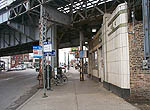
|
western-milwaukee05.jpg (105k) |

|
western-milwaukee06.jpg (78k) |
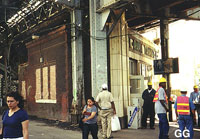 |
western-milwaukee07.jpg (132k) The Western/Milwaukee station is an unusual combination of styles: the sides and rear have the decorative brickwork of the original 1895 structure while the front has a stylish Art Deco facade that was added circa 1930. This view looks south in late July 2000, shortly before the station house was closed for reconstruction. (Photo by Graham Garfield) |
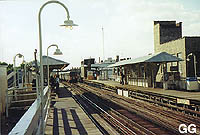 |
western-milwaukee08.jpg (73k) The platforms at Western/Milwaukee, looking northwest in the summer of 2000. The station's platform had many of its original 19th century features such as lights and canopies before modernization took place in 2000-01. (Photo by Graham Garfield) |
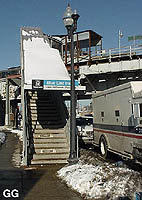 |
western-milwaukee10.jpg (77k) For the duration of construction when the station house is closed, access to the platforms is provided by specially-built stairways and temporary fare control booths on the west side of Western Avenue. When the station house reopens, they will become auxiliary exits. Looking north at the Loop-bound entrance on January 5, 2001. (Photo by Graham Garfield) |
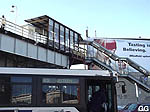
|
western-milwaukee11.jpg (91k) |
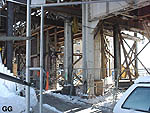
|
western-milwaukee12.jpg (125k) |

|
western-milwaukee13.jpg (116k) |
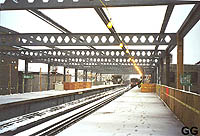 |
western-milwaukee14.jpg (112k) The Western/Milwaukee station platform, looking northwest on March 9, 2001. The new canopy structure is largely in place. (Photo by Graham Garfield) |
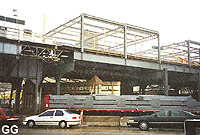 |
western-milwaukee15.jpg (107k) The Western/Milwaukee station complex, looking east on March 16, 2001. The juxtaposition between the new canopy under construction and the historic station facade below is already evident here. (Photo by Graham Garfield) |
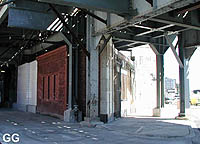 |
western-milwaukee16.jpg (90k) The new Western station house, which incorporates with historic side and front with a modern addition in the rear, looking south on July 13, 2001. It is interesting to compare this to the photo above, the same view before the renovation began. (Photo by Graham Garfield) |

|
western-milwaukee17.jpg (165k) |
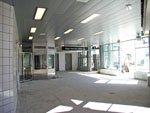 |
western-milwaukee18.jpg (197k) The new, modern interior of the Western station house, looking in from the street on July 13, 2001, 25 hours before reopening. The turnstiles and farecard vending machines are still yet to be installed. Work would continue inside the station house even after it opened for passenger use. (Photo by Graham Garfield) |
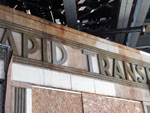 |
western-milwaukee20.jpg (215k) As work to restore the terra cotta Art Deco facade of the Western station is underway, the difference in color makes it evident in this July 13, 2001 view which panels have been cleaned or refurbished. (Photo by Graham Garfield) |
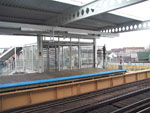 |
western-milwaukee24.jpg (253k) The auxiliary entrance/exit at the north end of the inbound Western station platform is seen looking west on November 30, 2001. The entrance was equipped with only one high-barrier gate (HBG) turnstile, but has room for additional HBGs in the future; there are also gates in the fencing that can be opened for additional capacity, equipped with a portable farebox if necessary. The stairs lead down to the west side of Western Avenue, facilitating transfers between southbound buses and the Blue Line without requiring passengers to cross wide, busy Western Avenue. (Photo by Graham Garfield) |
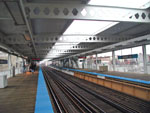 |
western-milwaukee25.jpg (248k) The rebuilt Western station platforms are seen looking southeast from the north end of the O'Hare-bound platform on November 30, 2001. The platforms are wide, providing increased capacity, and have extensive canopy coverage. Toward the middle, there are encloses with walls for additional weather protection. The ascending stairs visible farther down the platform lead to the overhead transfer bridge. Although not the transfer station per se, the bridge allows customers needing elevator access a connection to the O'Hare-bound platform (the elevator from the station house leads only to the Forest Park-bound platform and the bridge). It also allows someone who entered through the wrong auxiliary entrance another way to change platforms. (Photo by Graham Garfield) |
 |
western-milwaukee26.jpg (244k) The restored historic Art Deco Western station facade is seen looking south on November 30, 2001. A CTA rail station entrance sign has been installed over the sidewalk, in front of the entrance. (Photo by Graham Garfield) |
 |
western-milwaukee27.jpg (244k) The auxiliary entrance stair to the Forest Park-bound platform is seen looking north on Western Avenue on November 30, 2001. The southbound bus stop is immediately behind the photographer. A similar stair leading to the auxiliary entrance to the O'Hare-bound platform is ahead, on the other side of the alley and elevated structure, just out of view. (Photo by Graham Garfield) |
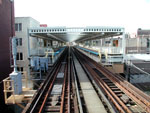 |
western-milwaukee29.jpg (253k) The Western station platforms are seen from south of the station, looking northwest on October 13, 2003. The boxy shape, and simple, utilitarian design of the platform and canopy structures are evident when viewed from a distance. (Photo by Graham Garfield) |
|
1. "Your New Blue." CTA website, accessed January 11, 2014.
2. "CTA Selects Your New Blue Contractor for Damen, Western and California station renovations" CTA press release. February 5, 2014.
3. Ibid.